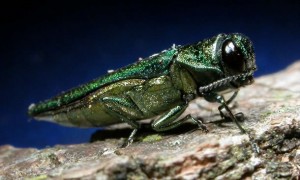By Nellie Brown

Photo from www.emeraldashborer.info
In the past few months, several news outlets have suggested that this winter’s frigid arctic blasts (also known as the polar vortex) may stop or at least slow the spread of the emerald ash borer (EAB). A recent study in Minnesota exposed emerald ash borer larvae to extremely cold temperatures, and they died. However, the larvae in this experiment were exposed to the extreme cold without any gradual acclimatization.
That’s very different from the way insects in nature go through winter. Many insect species in temperate climates, including much of the U.S., undergo a phase called diapause. Diapause, which is similar to hibernation in mammals, is a state of physiological rest where the insect can tolerate environmental extremes such as severe cold or very dry conditions. The insect doesn’t eat, drink, move, or do much of anything.
These physiological changes are induced by gradual changes in the length of day, temperature, and other environmental cues as the seasons change through the year. Some insects will even produce a sort of antifreeze in their blood which prevents actual freezing. These changes eventually result in diapause by the time winter arrives, and the insect is inactive, or nearly so.
In addition to diapause, emerald ash borers are also protected from extreme cold by the thick bark of the ash trees. So, exposing the larvae directly to very cold temperatures before they enter diapause is not a realistic measure of what happens in nature.
Poor experimental designs result in flawed results that only support wishful thinking. The extreme cold temperatures of this past winter may end up killing a few more emerald ash borers, but I doubt it will have a significant effect on their population as some people are hoping.
EAB continues to spread throughout the United States (including Missouri) and Canada, aided primarily by people transporting firewood infested with EAB larvae. To prevent the spread of this invasive pest, do not transport firewood and follow the state and federal quarantines published at the emeraldashborer.info website. And of course, include a diversity of native species in your landscape plantings to reduce the impact of calamities of this type in the future.
For more information, read this news article.
Nellie Brown has worked in the green industry for over fifteen years, first as a nursery inspector for the Missouri Department of Agriculture, now as an independent consultant and certified arborist. She helps people solve their insect and disease problems with their trees, garden and home (www.nelliebrownconsulting.com).


Thank you. While it isn’t the news I would wish for, I would rather have accurate information.
Thank you. While it isn’t the news I would wish for, I would rather have accurate information.
“A recent study in Minnesota exposed emerald ash borer larvae to extremely cold temperatures, and they died. However, the larvae in this experiment were exposed to the extreme cold without any gradual acclimatization.”
This is factually incorrect. Insects in the study were winter-acclimated and we know that the bark provides about 1°C of a buffer from air temperature at night. Some news agencies somehow start reported that the insects weren’t acclimated and somehow that rumor has persisted. I’d suggest reading the study:
http://www.fs.usda.gov/Internet/FSE_DOCUMENTS/stelprdb5191794.pdf